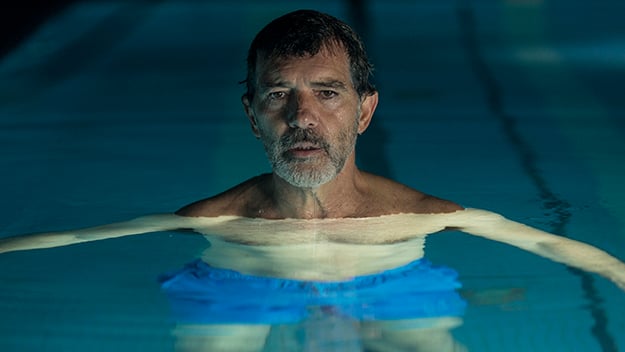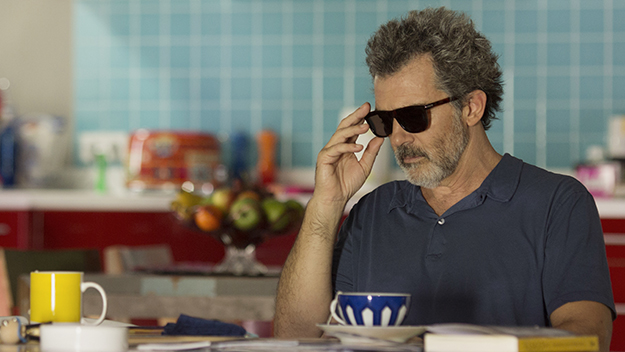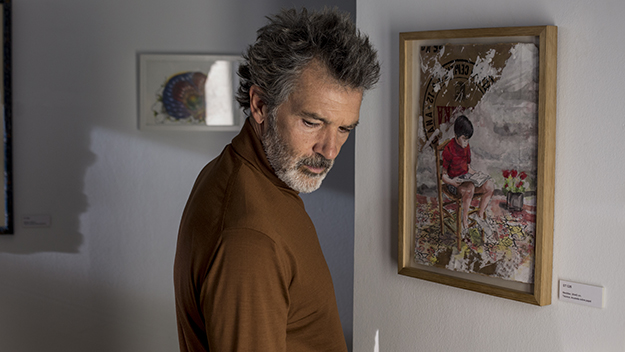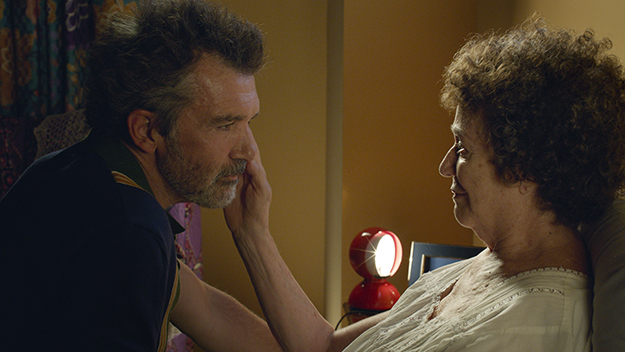An aging, afflicted, and lone filmmaker named Salvador (Antonio Banderas), his eyes closed and back marked by the scar from a spine operation, dives into the deep end of a swimming pool, submerging himself into an enchanted childhood memory of his mother (Penélope Cruz). She’s hand-washing laundry in the river with a natural detergent that attracts the attention of what she calls “soap fishes.” This evocative, nostalgic voyage back in time welcomes the viewer to Pain and Glory, Pedro Almodóvar’s heartrending, meditative, and deeply confessional culmination of his prolonged immersion in the waters of autofiction. The clues of this fictionalized self-portrait are hidden in plain sight: Banderas, in the role of a lifetime, wears Almodóvar’s messy hairstyle, flashy sweaters, and flowery shirts, and Salvador’s memories are in perfect sync with episodes from Almodóvar’s career. As a pretext for putting its physically, spiritually, and artistically stagnant protagonist into motion, the story knits one of its threads around a restoration of Sabor (Flavour), a movie Salvador directed 32 years earlier, to be presented at Madrid’s Spanish Cinematheque. Those happen to be the same number of years that have passed since the release of Law of Desire, whose restoration Almodóvar presented in 2017 at, yes, the Spanish Cinematheque. On that occasion he was accompanied by his greatest muse, Carmen Maura, while in Pain and Glory Salvador (the name is reminiscent of “Almodóvar”) intends to attend the premiere with Sabor’s star, a former and estranged alter ego played by Asier Etxeandia, in a veiled reference to actor Eusebio Poncela. It goes without saying that the third star of Law of Desire was Antonio Banderas, playing Poncela’s impulsive and psychotic young lover in his third collaboration with Almodóvar.
Given the amount of self-referential signposts throughout Pain and Glory, it’s tempting to read Almodóvar’s 21st feature as a kaleidoscopic rendering of his own creative and personal universe. The passionate, liberated, and libidinous life in 1980s Madrid is invoked through Salvador’s reunion with old collaborators and lovers, but also via a multilayered recalling of Law of Desire: Carmen Maura’s memorable enactment of Jean Cocteau’s monodrama The Human Voice here becomes a frustrated attempt to stage Cocteau’s Le bel indifférent, eventually replaced by an autobiographical monologue written by Salvador and called The Addiction; and, in one of Pain and Glory’s most vibrant and suspenseful moments, a mature man asks his long-time lover, delicately, “Do you want me to spend the night with you?”—the same question posed nonchalantly to Law of Desire’s protagonist by one of his fleeting lovers. Another past periodically visited by Pain and Glory is Salvador’s childhood, which represents the protagonist’s last connection to inner peace and innocence. This youth was an earthly children’s paradise ravaged both by religious dogmas and hypocrisy, as denounced by Almodóvar in Bad Education (“they made of me an absolute ignorant,” asserts Salvador about his first religious teachers) and by the material and emotional penuries of postwar Spain; Almodóvar synthesizes all this in an extraordinary double incarnation of her mother by Penélope Cruz (who reenacts her character in Volver but with an extra hint of distant resilience) and a heartbreakingly tenebrous Julieta Serrano. Another connection to Almodóvar’s past films is the similarity between Pain and Glory and Pain & Life, the title of an unfinished novel (which contained the premise of Volver) that was discarded by Marisa Paredes’s character in The Flower of My Secret, another of the filmmaker’s dissections of a creator’s tormented psyche. Despite the reported amount of self-references and apparent dualities—between avatars and real people, and between different incarnations of the same character—Pain and Glory is probably Almodóvar’s most cohesive movie, a remarkable accomplishment since the narrative doesn’t rely on stylistic mannerisms, a baroque take on melodrama, or self-reflexive meta-artifices: the ingredients that shaped the tones and narratives of Pain and Glory’s most direct predecessors, Law and Desire and Bad Education. In the new film, the unifying force comes first from the ubiquity of Salvador, Almodóvar’s doppelgänger and Banderas’s stroke of genius, an actor-director communion that can only make us dream what might have been between François Truffaut and Jean-Pierre Léaud later in life. Banderas’s leap from the impulsive, histrionic early characters in Law of Desire or Tie Me Up! Tie Me Down! to the sibylline, interiorized protagonist of The Skin I Live In may have been colossal, but nothing could have predicted the nuanced, expressive quietness the actor achieves in Pain and Glory. While watching Banderas’s Salvador accept his first-ever puff of heroin out of pure “curiosity,” I couldn’t stop thinking about Chaplin accepting his first-ever glass of rum before his execution at the end of Monsieur Verdoux. Let’s just call it a matter of humanity.
Salvador’s body, voice (his own or an accomplice reciting his words), or perspective are somehow present in almost every shot, including in subjective flashbacks of his homosexual awakening, which evoke the incandescent visions of Bud from Terence Davies’s The Long Day Closes. And though the singularity of Almodóvar’s writing always creates strong spiritual and rhetorical affinities between characters, Pain and Glory functions almost literally as a single-character film, not so much stream of consciousness or interior monologue, but a sort of cinematic account book of emotions, memories, sources of inspiration, loved ones, and life lessons. In this sense, the movie I thought about most while watching Pain and Glory, even more than 8½—an obvious reference underlined by the poster of Fellini’s film hanging in the office of Salvador’s personal assistant—was Nanni Moretti’s masterful Mia madre. Both movies wander around the afflictions, uncertainties, and scarce moments of solace of a filmmaker in crisis, and both emotionally culminate in the depiction of a filmmaker caring for an ailing mother. Throughout the film, Almodóvar explicitly invokes some of the authors who have shaped his literary sensibility, from Chekhov to Cocteau to Éric Vuillard, though the most pertinent reference is undoubtedly Fernando Pessoa’s The Book of Disquiet, the Portuguese poet’s inexhaustible celebration of autofiction, subjectivity, individualism, alienation, and integrity. Salvador reads the passage in which Pessoa claims, “I find life distasteful, like a useless medicine,” while Almodóvar could have quoted the Spanish critic and translator Manuel Moya, who described The Book of Disquiet as a “Umana commedia where heaven, hell and purgatory are interwoven in conflict, neutralizing each other to illuminate a space where the misery and grandeur of the human experience coexist.” Salvador recovers from the vault of his childhood memories some trading cards featuring Tyrone Power and Robert Taylor, while his autobiographical monologue invokes Niagara and Splendor in the Grass (this cinematic time capsule is brought up to date by the inclusion of a clip from Lucrecia Martel’s The Holy Girl of the young heroines drifting in a swimming pool—a film for which Almodóvar was executive producer). The recurrence of water imagery accounts for the particular fluidity of Pain and Glory, a movie riddled with transitions between different narrative time frames but cleared of the flashy dissolves and wipes that have become part of Almodóvar’s DNA. Almodóvar deploys diverse strategies in Pain and Glory to introduce flashbacks, sometimes through match cuts between analogous objects (a piano at a bar and the one played by a kid’s choir instructor; the jewelry boxes where Salvador’s mother keeps her Catholic rosaries, now and then), or periodical medium-shots and close-ups of Salvador closing his eyes, losing consciousness under the influence of drugs and submerging into childhood recollections. These simple but spellbinding moments bring to mind key scenes from such essential film noirs as Otto Preminger’s Laura (in which Dana Andrews falls asleep next to a portrait of the title character played by Gene Tierney) and Fritz Lang’s The Woman on the Window, where Edward G. Robinson falls asleep in a dream to wake up in reality. “Sometimes I’m inclined to lose track of time,” are the last words spoken by Robinson’s character before the film’s reins are handed to his subconscious, a phrase Salvador would definitely approve of. Far from the evident tributes to film noir Almodóvar devised in High Heels, Bad Education, Broken Embraces, and The Skin I Live In, Pain and Glory recaptures the dreamy atmosphere of the genre while maintaining a safe distance from its most morbid tendencies.
In line with the duality of its title, Pain and Glory balances its innate warmth with painful historical and medical realities: the misery of postwar Spain, the perils of drug addiction, and, most significantly, the protagonist’s inventory of maladies, including insomnia, arthrosis, ulcer, asthma, migraine, and tinnitus. All of these diseases are graphically described in an animation sequence by the Argentinian designer Juan Gatti, and evoked in vivid detail every time Salvador puts a cushion on the floor before kneeling to pick something up (“The days when several aches converge I believe in God and pray to him; the days I only suffer of one pain I’m an atheist,” says Salvador). The feeling of personal wreckage spreads throughout Salvador’s negotiation with his past: the memory of the breakup with an old lover (Leonardo Sbaraglia) is tinted with grief; a thin stream of mutual resentment hinders his reteaming with the protagonist of Sabor, with whom Salvador had creative differences; and his relationship with his mother is haunted by disillusionment and remorse. However, Pain and Glory doesn’t register as a settling of scores with—or an exorcism of—the past, but as a conciliatory exercise of remembrance, an array of dramatic reencounters the director faces with a restrained and ultimately moving stoicism—Akira Kurosawa’s Ikiru formally tempered by Yasujirō Ozu’s minimalism. Almodóvar observes with bright lucidity the course of a life and allows the notion of mortality to emerge from an imperturbable resignation—“avoid sentimentalism” Salvador tells his old collaborator regarding the stage adaptation of his autobiographical monologue. In fact, the highest praise one could dedicate to Pain and Glory would be to compare its profound, sapient serenity with the restrained but emotional charge of such monumental last films as John Huston’s The Dead or Carl Dreyer’s Gertrud. In order to find the clearest perspective on Salvador’s past and present, Almodóvar submits his filmmaking to a subtractive process, leaving little room for pop art, references to current political affairs (present only in a graffiti with a feminist slogan), or lengthy musical interludes (though there’s a mandatory bow to Chavela Vargas). Pain and Glory is guided by an austerity and quietude that only pulls back in the most exuberant childhood flashbacks. Cinematographer José Luis Alcaine builds scenes around middle-distance shots, not indulging in tracking or crane shots. And Almodóvar’s idiosyncratic color palette is replaced by a muted, more naturalist study of shadowy interiors—mainly Salvador’s flat, a studio replica of Almodóvar’s apartment with actual objects from the director’s home—and the possibilities of the color white, which covers the walls of the cave where the infant Salvador lives with his mother, and dominates a theater stage due to the imposing presence of a mostly blank film screen. Almodóvar’s drive toward subtraction—an exercise of style refinement and purification—causes a shift in the narrative paradigms, psychological mechanisms, and archetypical figures that constitute Almodóvar’s cosmology. In his world of wounded and vindictive characters, the Spanish auteur has long adopted the labyrinth as his favorite narrative geometry—the perfect device to capture the confusion of men and women in search for their own identities. He has used metafictions and unlikely coincidences to channel melodrama and amplify his characters’ traumas. However, Pain and Glory renounces ambiguity in order to embrace clarity. Here gender and sexuality are no longer a matter of conflict but of self-acceptance—the secretive and tormented trans characters of Law of Desire and Bad Education are here substituted for such characters as a former lover who feels free enough to talk about his bisexuality with his son. The metafiction of Pain and Glory is delivered with poignant subtlety, while the film’s narrative reliance on chance and unexpected encounters are less an opportunity for dramatic fireworks than for benign, tranquil dialogues with healing potential. In perhaps the film’s most revealing image, Salvador’s mother’s hands untangle a pair of Catholic rosaries, a perfect representation of the unraveling skein of memories, tête-à-têtes, and reflections that make up the transparent, fragmented, almost plotless narrative of Pain and Glory.
In this limpid, translucent version of Almodóvar’s world, characters don’t impersonate others; they know who they are and what roles they play in Salvador’s orbital system. And Almodóvar is not blind to his own social role. In the last few years, a new generation of Spanish historians, critics, and filmmakers have raised the need for a reconsideration of the legacy of the period known as “la Transición,” encompassing the years from the end of Franco’s dictatorship in the mid-1970s to the establishment of a democracy and the (now questioned) promise of a new time of freedom and sociocultural progress of the 1980s. One of the most significant moments of this recent debate was signaled by the publication of Cómo acabar con la contracultura (How to End Up with the Counterculture) by film and culture critic Jordi Costa, a book that makes an appearance in Pain and Glory when it is handed over to Salvador by his assistant. His reaction after reading the book’s titular rhetorical question out loud: “What do I know?” In the essay, while praising the evolution and persistence of the transgressive spirit of Almodóvar’s work, Costa argues that the countercultural revolution of that time—during which Almodóvar played a central role as a precursor of the movement known as La Movida Madrileña and an underground filmmaker—became “a lever used by the powers at be to liberate a deposit of libidinal energy which was subsequently exploited . . . by a system that doesn’t seem to have suffered a single scratch in the process.” Alongside this critique of the inability of Almodóvar’s generation to shake the foundations of Franco’s Spain, the cultural debate has pointed to Iván Zulueta’s 1979 film Rapture (Arrebato)—about a filmmaker (Poncela) who becomes friends with a childish man obsessed with cinema and heroin—as the film that best captured the spirit of its time while envisioning the genuine potential of an heterodox, countercultural cinema. Zulueta—who would design several posters for Almodóvar’s films—had to abandon filmmaking because of his addictions right after shooting Rapture, his second and last feature, which reinforced the cult standing of the movie and the director’s maverick status. This is all particularly relevant given the striking similarities between Pain and Glory and Rapture, two movies that deal with the attraction and damnation of heroin, and the memory of childhood as an absorbing refuge. However, the differences are also remarkable: in Rapture, cinema is presented as an all-consuming task inextricably linked to psychedelia, while Pain and Glory fashions cinema, and the arts, as a source of fulfillment and as a facilitator of human connection—the premiere of Sabor’s restoration brings together old collaborators, and the theatrical play reunites two old lovers. All in all, Pain and Glory is a fearless act of self-exposure in personal, artistic, and historical terms—a double-edged brushstroke of melancholy and lust for life, and a sublime addition to the Almodóvar pantheon. Manu Yáñez-Murillo is a film critic and journalist, and has written for Fotogramas, Rockdelux, Ara, and Otros Cines Europa. He is the editor of the anthology La mirada americana: 50 años de Film Comment.




